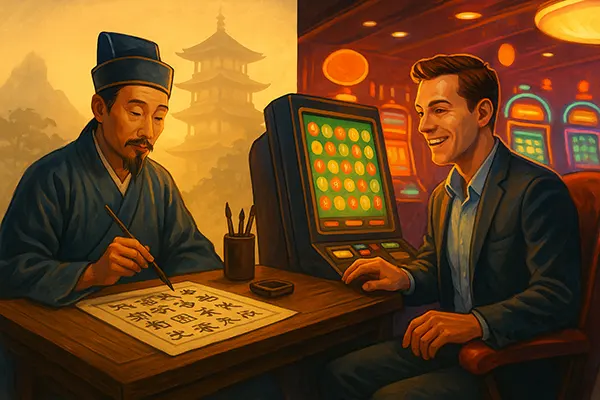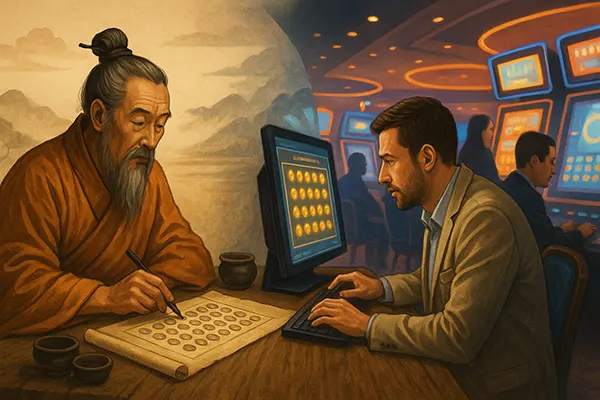
Evolution of Keno: From Ancient China to Digital Casinos
Keno has a history that stretches back more than two millennia, evolving from an ancient Chinese lottery to a globally recognised digital game. Its transformation reflects the development of societies, technologies, and the way people seek entertainment. Understanding how Keno has changed over centuries offers a fascinating view of human culture and innovation.
Origins of Keno in Ancient China
The earliest form of Keno, known as “Baige Piao” or “White Pigeon Ticket,” appeared during the Han Dynasty around 200 BCE. The game used Chinese characters instead of numbers, and local governors often used it to raise funds for public projects such as the Great Wall of China. It quickly became a social activity, uniting communities through shared anticipation and chance.
Results of the draws were delivered by messenger pigeons, giving the game its historical name. The simplicity of the rules—selecting symbols and waiting for them to match—made it accessible to everyone. This balance of excitement and community spirit laid the foundation for its endurance over centuries.
Over time, Baige Piao evolved into a more organised form of play. Regional differences emerged, but the core principle remained the same: prediction and luck intertwined in a game that mirrored the human fascination with fortune and destiny.
Keno’s Journey to the Western World
Chinese immigrants brought Keno to North America in the 19th century, introducing it as the “Chinese Lottery.” The game adapted to Western preferences, replacing characters with numbers and streamlining the drawing process. Its appeal quickly spread beyond the Chinese communities, becoming a part of American gambling culture.
By the early 20th century, Keno had found a home in Nevada. Legal casinos incorporated it as a regulated game, ensuring transparency and fairness. The introduction of printed tickets, mechanical drawing machines, and scheduled draws turned Keno into a form of structured entertainment enjoyed by millions.
These innovations helped transform Keno from a community pastime into a mainstream casino game. Its balance of simplicity and anticipation made it timeless, capable of capturing attention without complex rules or strategies.
The Modernisation of Keno in the 20th Century
The 20th century marked a period of significant change for Keno. As gambling regulations evolved, the game spread across continents, adapting to new social and technological conditions. Electronic number generators replaced manual draws, and video terminals introduced faster gameplay, offering immediate results and excitement.
Casinos began to integrate Keno lounges, allowing players to watch live drawings throughout the day. The game’s low entry cost and simple mechanics made it appealing to casual participants who preferred a relaxed form of entertainment. Keno’s flexibility meant it could coexist with both traditional table games and modern slot-style experiences.
By the late 1990s, Keno had already taken its first steps into the digital era through video machines. These offered players colourful graphics, sound effects, and rapid rounds, combining tradition with technology in a way that felt both nostalgic and new.
Transition to Digital Keno
The introduction of the internet at the turn of the millennium brought a revolution to Keno. The game went online, allowing players to participate from anywhere, anytime. Digital versions preserved the original number-selection concept but added features such as adjustable betting ranges, interactive designs, and automated draws.
Online Keno also became part of licensed and regulated gambling markets, ensuring that outcomes were generated by certified random number generators (RNGs). This transparency strengthened player confidence and allowed the game to thrive in competitive global environments.
Modern digital Keno now includes themed versions, progressive jackpots, and social play elements, making it suitable for both individual enjoyment and community participation. The blend of ancient simplicity with modern innovation defines its enduring success.

The Future of Keno in the Digital Age
The evolution of Keno is far from complete. The 2020s and beyond promise further advancements driven by artificial intelligence, blockchain technology, and virtual reality. These developments aim to create secure, immersive, and transparent experiences that maintain the essence of Keno while enhancing engagement.
Blockchain-based systems can record every draw permanently, eliminating doubts about fairness. Meanwhile, virtual reality could introduce 3D environments where players watch live draws in digital casinos that replicate the atmosphere of real venues. Mobile accessibility ensures that Keno remains convenient and adaptable to future generations.
Most importantly, responsible gaming practices have become integral to the modern experience. Time limits, deposit controls, and educational tools are standard, helping players enjoy Keno safely and sustainably while preserving its cultural heritage.
Keno as a Reflection of Cultural Continuity
From its humble beginnings in ancient China to its high-tech digital reinvention, Keno has remained a symbol of human creativity and hope. It represents the balance between chance and choice, simplicity and innovation. Every stage of its evolution has mirrored the broader changes in civilisation and technology.
Keno’s story is not just about gambling—it is about connection, tradition, and progress. Whether played with handwritten tickets, video screens, or on a smartphone, its core remains timeless: the thrill of numbers drawn and the anticipation of what comes next.
As it enters the next stage of evolution, Keno continues to link the past with the future, showing how an ancient idea can thrive in the digital age without losing its soul.
